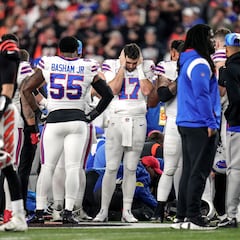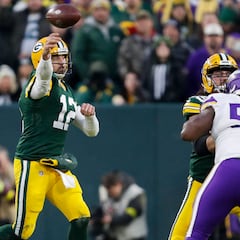Do NFL teams have team nurses? How much do the medical personnel get paid?
Have you ever wondered about the medical staff on the sidelines in the NFL? We take a look at the career and earning potential of team doctors and trainers


We all just called him “Doc”. Before and after every practice, every game, we would line up outside his office and have our wrists or ankles taped up. I started this ritual when, as a sophomore in high school, I tore a tendon in my left thumb. A young student named Johnny followed him around and buzzed amongst us at Friday night games, a belt that held water bottles and tape and scissors dangling around his waist. I asked him once what he wanted to do after high school and he told me flatly that he was going to study sports medicine and be a team trainer. “Didn’t you ever want to play?” I asked him. “No, this is what interests me.” No hesitation in his voice, no wavering in his gaze. He definitely meant it.
Related News:
- Damar Hamlin’s toy fundraiser tops $3 million: how to donate
- Bills’ Hamlin in critical condition after collapsing on field
- NFL weighing in on Watt: “it’s really heavy”
Wishing a very happy birthday to football athletic trainer and resident athletic training room DJ @edubb719! Have a great one Ed! pic.twitter.com/fNBvYN6WzC
— UCF Sports Medicine (@UCF_SportsMed) November 9, 2021
East Ascension High School was no different than any other in the country. There would have been tens of thousands of scenes like these played out in every corner of North America. At the time, we football players didn’t really think too much about Johnny’s career prospects. We were going to get a scholarship to a Division 1 school, and then drafted into the NFL. That was our career path laid out before us. In the end, only about 20% of the team went on to play college football, only three at Division 1 level, and of all the hundreds of guys I played with or against, only one made it to the NFL. The rest of us drifted into other career options, other sports, and moved on with our lives. I lost touch with Johnny and never knew what became of him. But if I were a betting man, I would lay my money on him coming closer to realizing his dream than any of us did ours.
❗️WE'RE HIRING❗️
— CGTC Titans (@CGTCAthletics) November 10, 2021
Central Georgia Technical College is hiring a full-time Athletic Trainer! Help us spread the word to anyone who might be interested!
Visit https://t.co/OsjbLjgb8Y for more details. pic.twitter.com/k8HIeHQVj3
Studying sports medicine would definitely have put him on the right track. He may have wanted to work at the high school level or perhaps for an NCAA program, but if we assume that Johnny wanted to practice sports medicine at the top level, he would have been looking to join an NFL team medical staff. According to the NFL Physician Society, every game will involve 29 medical professionals, both on the sidelines and inside the stadium itself.
The team doctor
The roles involved may surprise you. For example, would you immediately associate NFL stadium medical staff with dentistry? No, neither would I. But of course if you are the player who just had his teeth knocked out, you would definitely want a dentist to be handy. The same applies to the stadium ophthalmologist or the radiologist. In fact, of the 29 game-day medical staff, only four are definitely primary care physicians. The rest are highly specialized medical professionals; two neurologists, one airway management physician, two chiropractors, four orthapedists. And these team doctors, for licensed medical doctors they are, can earn in the range of $200,000 and $512,500 per year. If they are working in an NFL medical facility it can be even more. Of course, just as any doctor in the country, the NFL doctors must have completed four years of undergraduate study, four years of medical school, four to five years of residency and normally at least one year of fellowship training.
Congrats to Dr Walt Lowe @orthosport .. 2018 Jerry “Hawk” Rhea , NFL Physician of the year winner @pfats_com @HoustonTexans #nflps pic.twitter.com/T0kYTLXFf5
— Geoff Kaplan (@kapPTATC) March 2, 2018
But what if you aren’t a doctor? Are there other openings for nurses, paramedics, physiotherapists? This is fact makes up the largest group of medical staff in the NFL. In any game are the ten athletic trainers, four for each team and two independent.
Cowboys WR Amari Cooper (hamstring), CeeDee Lamb (ankle) and Michael Gallup (calf strain) all did rehab work in practice today with athletic trainer Britt Brown. CB Trevon Diggs (ankle) seemed to be just fine. pic.twitter.com/HKWIlHa3vF
— Clarence Hill Jr (@clarencehilljr) November 4, 2021
What is an athletic trainer?
An athletic trainer is a health care professional who specializes in sports medicine, rehabilitative care, physical therapy, and preventative care. They may have a degree in athletic training, exercise physiology or kinesiology, or may have trained initially as a nurse before moving on to sports medicine as a speciality. Generally, the athletic trainer will hold a Bachelor’s, or more commonly a Master’s Degree in nursing and one or several specialities. If Johnny went down the road of plying his trade for an NFL team, he would have expected to earn between $75,000 and $100,000 per year.
Broncos’ Athletic Trainer Steve “Greek” Antonopulos is retiring after 45 seasons with the team. He is believed to be the longest-tenured trainer with one team in NFL history, and Greek is the only person to be a part of all eight Broncos’ Super Bowl appearances. What a run. pic.twitter.com/QngbUDNhEI
— Adam Schefter (@AdamSchefter) June 7, 2021
Related stories
Like all medical staff, athletic trainers are required to stay current in their skills, meaning regular Professional Development Courses and training are part of the job. They will work often 12-hour days throughout the year and travel with the team throughout the season. And one thing that has changed, for the better I hasten to add, since my high school days talking to Johnny as Doc wrapped by wrist, is that more and more women are working in on-field medical roles.
As one of six female athletic trainers in the @NFL, Allison Miner is living her dream. #NGWSD
— Los Angeles Chargers (@chargers) February 6, 2019
Perhaps the greatest key indicator for the career progression towards athletic trainer is the projected employment numbers. The field is expected to grow by 23% in the coming decade and the NFL is only one outlet. In addition to every professional sport making use of their skill set, MLB, NBA, and NHL for example, every one of those sports needs staffing at the college and high school level. And outside of the team-based or league-based jobs, recreational and sports centers as well as public and private hospitals are also employing athletic trainers. It looks like Johnny’s career plan was certainly more sound than our “poke-and-hope” approach to making it to the NFL. If I were advising my child today, I would tell them to put away the shoulder pads and start focusing on sports medicine.

